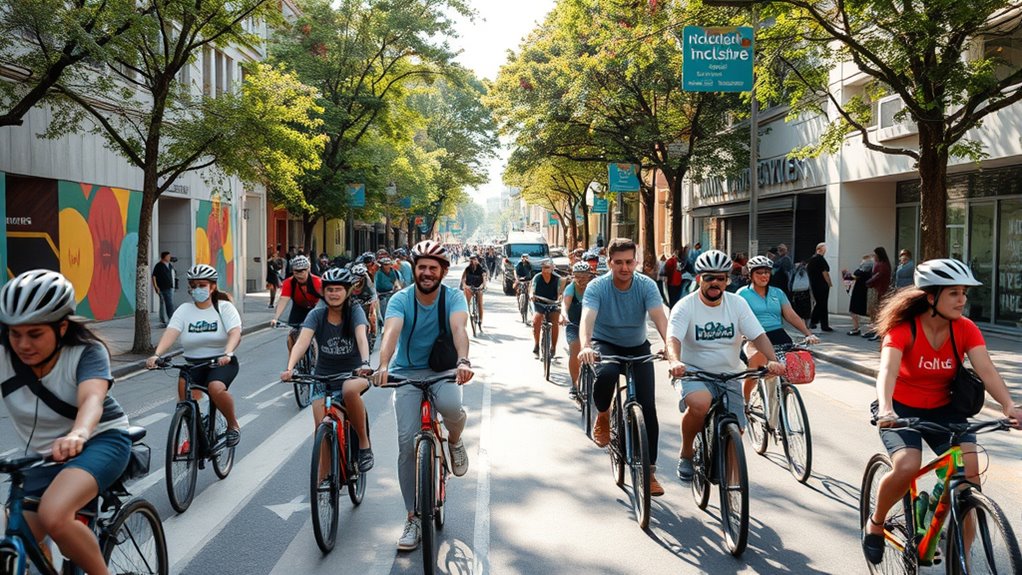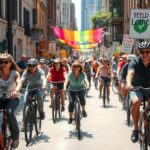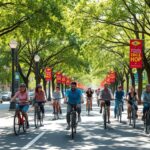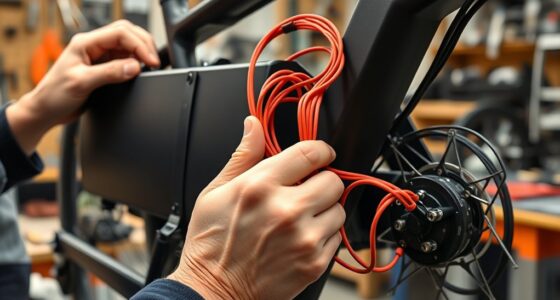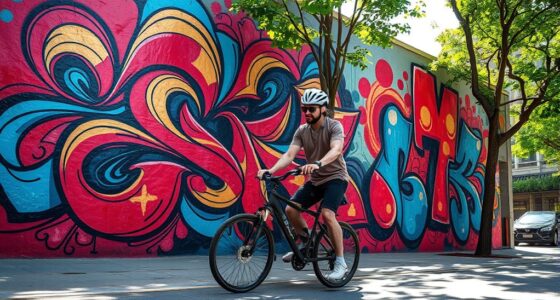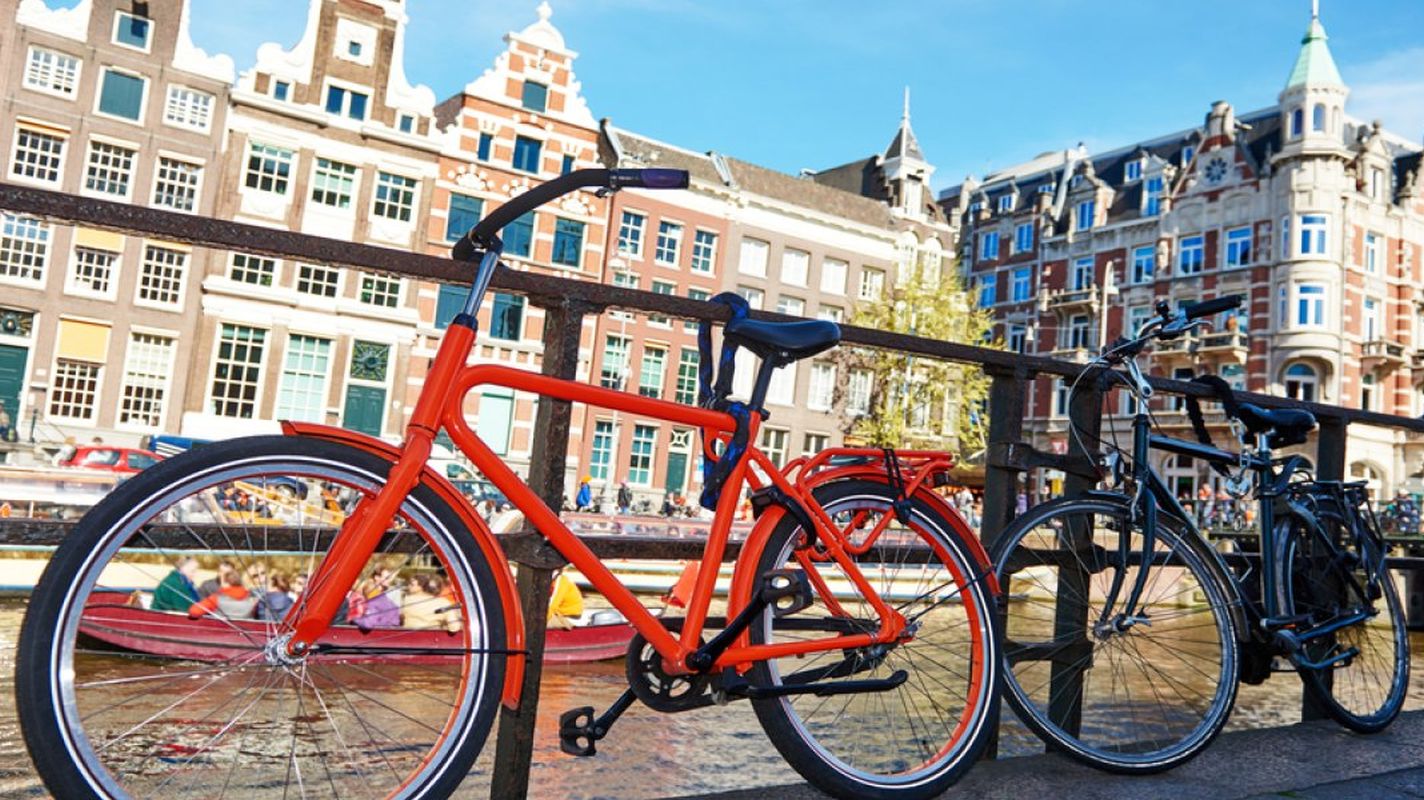To build inclusive cycling communities, focus on engaging local residents in planning and designing infrastructure that reflects their needs. Foster regional collaborations, support grassroots initiatives, and share community stories to inspire others. Secure diverse funding and measure progress through ongoing feedback. By prioritizing equity, partnership, and community-driven efforts, you can create vibrant, accessible networks. Stay with us to explore real success stories and effective strategies that turn inclusion into action.
Key Takeaways
- Engage local communities through participatory planning and grassroots initiatives to ensure infrastructure reflects diverse residents’ needs.
- Design inclusive infrastructure with features like bike boxes and diversified connectivity to improve safety and access for all riders.
- Foster regional and cross-boundary collaborations to create continuous, accessible cycling networks across neighborhoods.
- Share community stories and success examples to build trust, promote ownership, and showcase inclusive cycling achievements.
- Secure diverse funding sources and implement impact measurement to sustain equitable cycling programs and monitor progress.
Embracing Hyperlocal Collaboration and Community-Led Planning
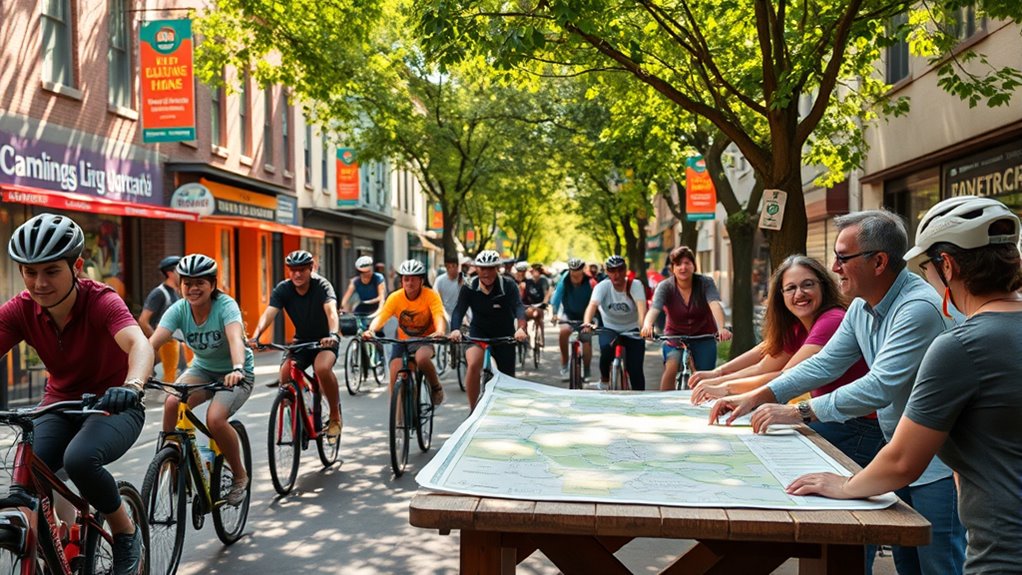
Why is hyperlocal collaboration essential for building inclusive cycling communities? It guarantees that residents directly influence their neighborhood’s cycling future through hyperlocal engagement. Community-led planning empowers local voices, making infrastructure projects more relevant and effective. Initiatives like Pop Up Meetings in Saint Paul and Bike Network Benchmarking videos in Chicago foster trust and participation. Neighborhood-specific safety guides, such as Washington, D.C.’s Quick Guides, address unique needs and promote awareness. Regional collaborations, like the Olympic Discovery Trail and Atlanta BeltLine, connect communities, broadening support for biking. Local organizations such as Sequim Wheelers actively involve residents, advocating for equitable access. When local governments support zoning reforms and funding, they reinforce the importance of community-driven planning, laying the foundation for truly inclusive cycling. Additionally, understanding the role of project technology in planning can help tailor solutions to local needs and improve accessibility. Developing Cultural Intelligence within planning teams can further enhance engagement with diverse communities, ensuring that initiatives are respectful and responsive to different cultural perspectives. Recognizing the nutritional advantages of green juice can also inspire healthier community activities and promote well-being among residents. Engaging in local legal resources can assist communities in navigating regulations related to infrastructure development and safety standards. Moreover, utilizing cost-effective planning tools can maximize limited budgets and expand the reach of inclusive projects.
Advancing Equitable Development Through Bicycle Infrastructure

Building on the momentum of community-led planning, advancing equitable development through bicycle infrastructure focuses on ensuring that all residents benefit from safe, accessible cycling networks. Your campaign aims to address disparities by supporting projects like Chicago’s bikeway initiatives that enhance connectivity and prioritize underserved communities. Washington, D.C.’s bike boxes improve safety and visibility for riders from diverse backgrounds, demonstrating inclusive infrastructure. Bend, Oregon uses Neighborhood Connectivity Analysis Maps to identify infrastructure gaps and promote equitable access across neighborhoods. The FHWA Bikeway Selection Guide offers essential data to analyze traffic stress and plan bikeways that serve all users. By fostering regional trail networks like the Olympic Discovery Trail, the cycling industry promotes inclusive mobility, setting the stage for the next edition of equitable cycling development.
Connecting Neighborhoods and Fostering Regional Partnerships

Connecting neighborhoods through regional trail networks makes cycling more accessible and encourages shared infrastructure. Cross-boundary collaborations, like zoning reforms, help build interconnected bikeways and parking standards. By working together across communities, you can create a more inclusive and efficient cycling system for everyone. Incorporating best practices for community engagement ensures diverse perspectives are considered, fostering stronger support and sustainable growth of cycling initiatives. Additionally, understanding juice cleansing and detox principles can inspire health-focused community programs that promote active lifestyles and wellness. Recognizing the importance of hydration and nutrition is crucial in supporting cyclists’ health and endurance during community events and training. Utilizing low light office plants in community centers can also create welcoming environments that encourage participation and well-being. Emphasizing nutritional insights from apple juice can highlight simple ways to promote healthy hydration options within community programs.
Regional Trail Networks
Regional trail networks serve as essential links that unite neighborhoods and strengthen regional partnerships, making bike travel more seamless and accessible. Trails like Washington’s Olympic Discovery Trail connect multiple communities, boosting regional mobility and economic growth. Collaborative planning efforts, such as San Luis Obispo’s Bicycle Transportation Plan, help fund and develop interconnected bikeways, ensuring that different areas work together. Washington, D.C., has removed auto parking minimums and added bike parking requirements, supporting infrastructure that encourages cycling across regions. The Atlanta BeltLine exemplifies how connecting neighborhoods can revitalize urban spaces and promote active transportation. Community groups like Sequim Wheelers actively support and advocate for regional biking initiatives, fostering shared stewardship and community engagement. These networks create a more inclusive, connected, and vibrant cycling environment, especially when bike-friendly infrastructure is prioritized within the planning process. Building regional connectivity is fundamental to expanding access and ensuring everyone can enjoy the benefits of cycling, which also enhances overall community health and well-being. Additionally, incorporating inclusive design principles ensures that cycling infrastructure accommodates diverse users and abilities, fostering greater inclusivity. Implementing diversified funding sources can further sustain and expand these regional networks, ensuring long-term success and resilience.
Cross-Boundary Collaboration
Cross-boundary collaboration plays an essential role in creating cohesive cycling networks that span neighborhoods and municipalities. By connecting different communities, you can develop continuous, multi-use corridors that improve regional mobility and accessibility. Successful examples, like Washington State’s Olympic Discovery Trail, demonstrate how linking multiple areas benefits everyone. Reforms such as removing auto parking minimums and establishing shared bike parking standards across jurisdictions make planning easier and promote equitable infrastructure. Community groups like Sequim Wheelers show how regional coordination supports inclusive participation and strengthens biking initiatives across borders. When local governments and organizations work together, resources are shared more efficiently, policies are aligned, and extensive plans emerge. This collaborative approach ensures that cycling infrastructure is sustainable, accessible, and beneficial for all residents. Additionally, incorporating natural materials and thoughtful design principles from farmhouse decor can inspire sustainable and inviting cycling hubs that blend seamlessly with the environment. Moreover, integrating vetted ideas from different regions enhances the quality and sustainability of the cycling networks. Engaging with innovative transportation technologies, such as electric bikes, can further support inclusive mobility and expand access for a broader range of users. Building regional partnerships also facilitates the sharing of best practices, which accelerates the development of effective cycling infrastructure across communities. Furthermore, leveraging existing water parks and recreational spaces can serve as community hubs and starting points for cycling routes, encouraging more residents to participate in active transportation.
Building Sustainable Teams and Community Support Structures

Building sustainable teams and community support structures is indispensable for the long-term success of cycling initiatives. You should establish dedicated committees, like Fort Collins’ Bicycle Advisory Committee, to guide ongoing infrastructure and program development. Recruiting diverse stakeholders—local residents, advocacy groups, and city officials—ensures broad support and shared ownership. Creating support structures, such as Santa Rosa’s Inclusion Council, helps foster equitable participation by addressing barriers and encouraging inclusive engagement. Securing consistent funding through grants or partnerships, like adaptive bikeshare programs, is crucial for maintaining and expanding efforts. Additionally, ongoing training, leadership development, and volunteer engagement keep momentum alive and ensure your community’s cycling initiatives thrive over time. Building these foundations guarantees lasting impact and wide-reaching support. Building inclusive communities creates a welcoming environment that encourages participation from all demographics and enhances the sustainability of cycling programs.
Securing Funding and Resources for Long-Term Success
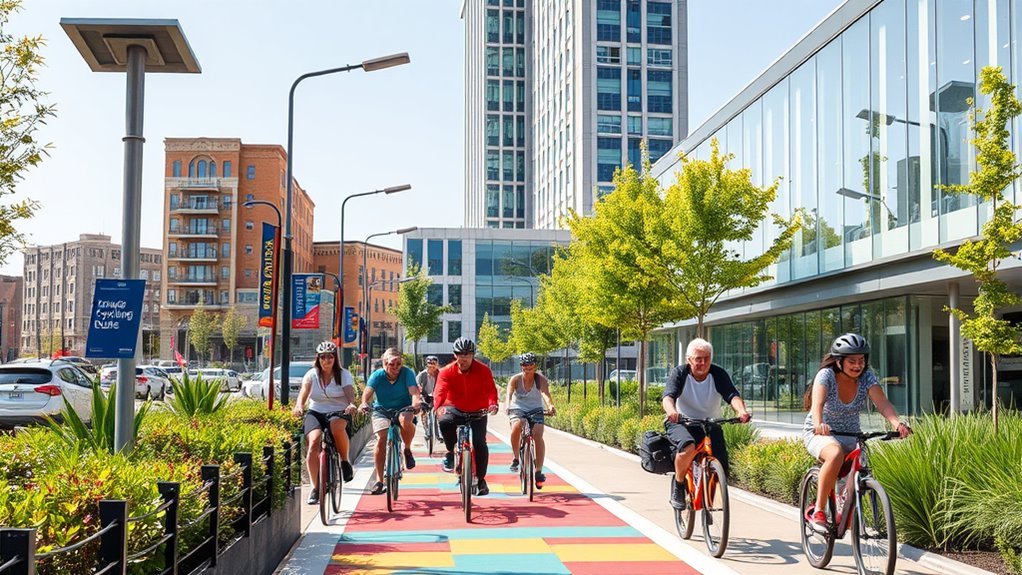
Securing funding and resources is vital for maintaining and expanding cycling initiatives over the long term. You should explore diverse sources like federal grants, local government budgets, and private donations to guarantee financial stability. The League of American Bicyclists offers valuable resources and data to help you identify and access the right funding opportunities. Building public-private partnerships with local businesses and organizations can provide additional support and resources. Consider establishing dedicated funding streams, such as bike-specific taxes or fees, to secure ongoing investment. Transparency and effective management of these funds are essential—they build community trust and demonstrate your commitment to long-term cycling development. With solid financial backing, your cycling community can grow sustainably and inclusively.
Showcasing Grassroots Initiatives and Community Stories

You can see how grassroots projects like the Community Cycling Center are changing neighborhoods by prioritizing underserved communities. Personal stories from groups such as ABC Program and Finland’s “Immigrants on Bike” show how inclusion creates stronger, more connected communities. Sharing these initiatives highlights the power of community-led efforts to build truly accessible cycling environments.
Community-Led Projects
Community-led projects play a vital role in creating inclusive cycling communities by empowering residents to shape their local infrastructure. These grassroots efforts focus on engaging underserved populations, like Cully in Portland, through storytelling and advocacy. Multilingual outreach and culturally relevant content guarantee everyone feels included, as seen in initiatives translating interviews into English and Spanish. Local groups, such as the Community Cycling Center, amplify voices with documentary videos and social media campaigns, highlighting disparities and successes. When neighborhoods drive planning, city policies often shift, increasing funding for equitable infrastructure. These projects foster social bonds, empowerment, and ownership among residents, building stronger, more resilient cycling communities.
| Voices Heard | Impact Created | Community Growth |
|---|---|---|
| Residents share stories | Infrastructure improves | Neighborhoods unite |
| Diverse languages | Policies change | Trust and pride grow |
| Local efforts matter | Resources increase | Resilience builds |
Personal Stories of Inclusion
How do personal stories shape the movement for inclusive cycling? They give voice to those impacted by infrastructure gaps and social barriers, making issues tangible. Grassroots initiatives like Portland’s ABC Program leverage storytelling and translation services to amplify underserved communities’ experiences. These personal narratives reveal how unsafe routes isolate residents from jobs, schools, and healthcare, highlighting the need for equitable infrastructure. Video projects featuring community members’ stories use authentic visuals and local locations to show both challenges and victories. Sharing these stories raises awareness, builds empathy, and sparks support for grassroots efforts. By putting faces to the issues, personal stories inspire broader participation and influence infrastructure improvements, fostering a sense of belonging and inclusion among marginalized groups in cycling communities.
Highlighting Inclusive Program Models and Innovative Outreach
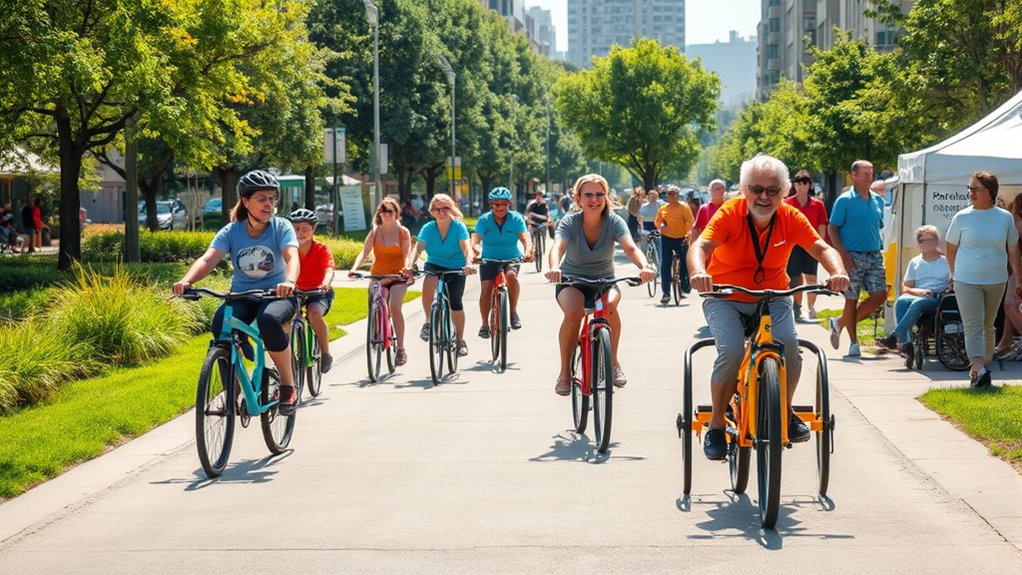
Highlighting inclusive program models and innovative outreach strategies reveals how cities and organizations are actively expanding access to cycling for all populations. You’ll see initiatives like Portland’s ABC Program, which uses multilingual outreach and community-led events to connect underserved groups. Finland’s “Immigrants on Bike” program offers free lessons to help newcomers feel confident on bikes, fostering social integration. Innovative approaches like cargo bikes and rickshaw programs, such as Cycling Without Age, promote intergenerational connections. Data shows these efforts boost participation among women, seniors, and marginalized groups, creating more equitable cycling communities. Cities like Gdynia and those in the EU have integrated accessible infrastructure with targeted outreach, emphasizing equity, diversity, and community empowerment. These models demonstrate how thoughtful strategies can broaden cycling access for everyone.
Measuring Impact and Promoting Ongoing Engagement
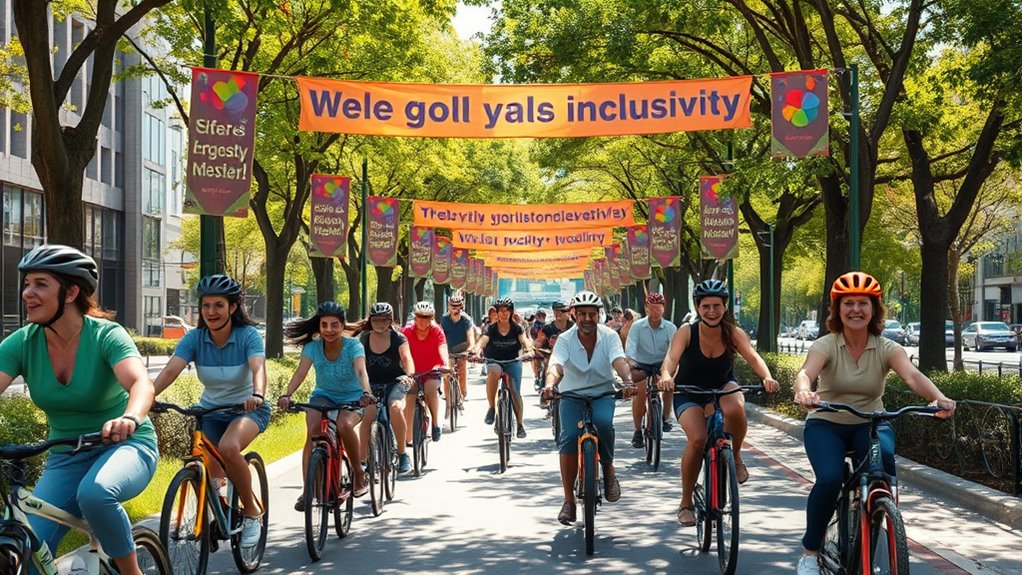
To guarantee inclusive cycling initiatives continue to grow and improve, regularly measuring impact and encouraging ongoing engagement are essential. You can do this by implementing surveys and feedback mechanisms to track participation and identify gaps. Data analytics help you measure increases in bike ridership, diversity, and access improvements. Success stories gain visibility through storytelling, social media, and community events, reinforcing ongoing involvement. Partnering with local organizations fosters sustained collaboration and engagement. Monitoring participation demographics and infrastructure usage allows you to adapt strategies for long-term inclusivity.
| Strategy | Benefit |
|---|---|
| Regular surveys and feedback | Track engagement, identify participation gaps |
| Data analytics | Measure ridership, diversity, access |
| Storytelling & social media | Amplify success, boost involvement |
| Community partnerships | Sustain collaboration, ongoing engagement |
| Usage monitoring | Adapt strategies, ensure inclusivity |
Frequently Asked Questions
How Can Communities Effectively Engage Marginalized Populations in Cycling Initiatives?
To effectively engage marginalized populations in cycling initiatives, you should actively listen to their needs and barriers. Offer accessible, affordable bikes and create safe, welcoming spaces. Partner with local organizations to build trust and promote inclusivity. Use targeted outreach through community events and multilingual materials. By fostering genuine relationships and addressing specific challenges, you help guarantee everyone feels valued and motivated to participate in cycling activities.
What Strategies Ensure Accessibility for Riders With Disabilities?
To guarantee accessibility for riders with disabilities, you should prioritize inclusive infrastructure like smooth, wide paths and adaptive bike lanes. Provide accessible bikes and equipment, such as handcycles or tricycles, and install clear signage. Offer training and support tailored to different needs, and involve disabled riders in planning. By actively listening and adapting your community’s facilities, you create a welcoming environment that encourages everyone to participate safely and comfortably.
How Do Cultural Differences Influence Cycling Promotion Efforts?
Cultural differences are like spices in a recipe—you need the right blend to make it appealing. When promoting cycling, you must understand local values, traditions, and attitudes toward transportation and outdoor activities. Respecting these differences helps you tailor messages and programs that resonate. Engage community leaders, adapt campaigns to cultural norms, and celebrate local stories. This approach fosters trust, encourages participation, and ultimately creates a more inclusive, vibrant cycling community.
What Role Does Policy Play in Sustaining Inclusive Cycling Programs?
Policy is essential for sustaining inclusive cycling programs because it provides the necessary support and resources. When you advocate for supportive policies, you help secure funding, infrastructure, and safety measures that make cycling accessible for everyone. Policies also set standards that promote equity and inclusiveness. By engaging with policymakers and communities, you can guarantee that inclusive cycling remains a priority, creating lasting change and expanding opportunities for all riders.
How Can Technology Be Leveraged to Improve Inclusivity in Cycling Communities?
You might think technology only benefits urban planning, but it actually plays a vital role in making cycling communities more inclusive. By using apps that identify accessible routes, real-time safety updates, and multilingual platforms, you can guarantee everyone feels welcome and safe. Leveraging wearable tech and virtual communities also helps connect diverse cyclists, breaking down barriers. Embracing these tools actively fosters a more inclusive, supportive cycling environment for all.
Conclusion
By embracing local collaborations and community-led planning, you can create inclusive cycling spaces that truly serve everyone. Imagine a neighborhood where diverse voices shape bike lanes, fostering trust and participation. For example, a community-led project in Portland successfully increased cycling among underserved groups by involving residents from start to finish. Your efforts in building sustainable teams, securing resources, and celebrating grassroots stories will guarantee your inclusive cycling community thrives long-term and inspires others to follow.
